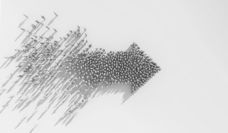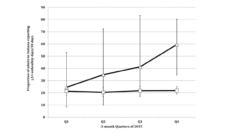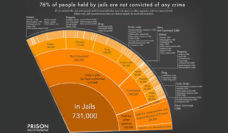Before this summer, I had never given serious thought to the experiences of youth in the juvenile justice system. Sadly, that’s kind of the point. Incarcerated members of our communities are treated as out of sight, out of mind. The further I got into my research within a juvenile justice agency, the more I thought “how did I not know this?” In this viewpoint, I’ll share a primer on a subject that most of us don’t devote a lot of brainspace to: LGBTQ+ youth in the juvenile justice system. How do LGBTQ+ youth get into the system? What happens once there? And why should we care?
Around 800,000 youth are arrested each year in the United States. Though the juvenile justice system is often portrayed as a last resort for the most serious youth offenders, less than a quarter of youth in juvenile justice custody have been charged with a violent crime.
The racial gap in youth incarceration is growing. Black youth are four times more likely to be committed than white youth, Native American 3 times more likely, and Latinx youth 61% more likely.
Further, almost 40% of the girls in the juvenile justice system are lesbian, bisexual, or queer. The vast majority of these girls are Black and Latinx. LGBTQ+ girls are more than twice as likely to be involved in the juvenile justice system than straight, cisgender girls.
Why do so many LGBTQ+ youth, especially Black and Brown girls, become involved in the juvenile justice system? A lot is stacked against them. Queer and trans youth often face family rejection and are more likely to be homeless than their peers. They are at increased risk of developing substance use problems and being sex trafficked. Queer and trans youth are also more likely to come into contact with law enforcement compared to their non-LGBTQ+ peers.
LGBTQ+ youth of color are among the least likely to benefit from efforts to decrease the use of incarceration. For me, that begs the question: is there such thing as an equitable “justice” system?
Part of the disparity comes from inequitable punishment. LGBTQ youth, particularly girls and youth of color, are more likely to be expelled from school than heterosexual youth for similar infractions. They are also twice as likely as their heterosexual peers to be detained for non-violent offenses such as running away, prostitution, and truancy. Stereotypes of lesbian and bisexual girls as sexually predatory may play a factor in unfair sanctioning and criminalization.
LGBTQ+ youth likewise face unique challenges once within the juvenile justice system. Transgender youth are often placed in facilities inappropriate to their gender identity and are more likely to be placed in isolation. LGB+ youth report higher rates of sexual contact with staff and peer sexual assault than their straight peers. LGB+ youth tend to be incarcerated longer than straight youth. The longer youth are in the system, the worse their adult mental and physical health is likely to be.
Juvenile justice system involvement has lasting impacts. Any incarceration during adolescence or young adulthood is associated with worse health throughout the lifecourse. Confinement erodes mental health. Incarceration disrupts social networks and financially devastates youth for years to come. Together, these factors contribute to high rates of fatal drug overdose, suicide, and post-traumatic stress.
The juvenile justice system is in the midst of massive reform. The number of youth committed in the US has been cut in half in the past 20 years. Juvenile justice agencies across the US are shifting focus from surveillance and punishment towards youths’ assets, health, and well-being. LGBTQ+ youth of color are among the least likely to benefit from efforts to decrease the use of incarceration. For me, that begs the question: is there such thing as an equitable “justice” system?
Photo via Getty Images














